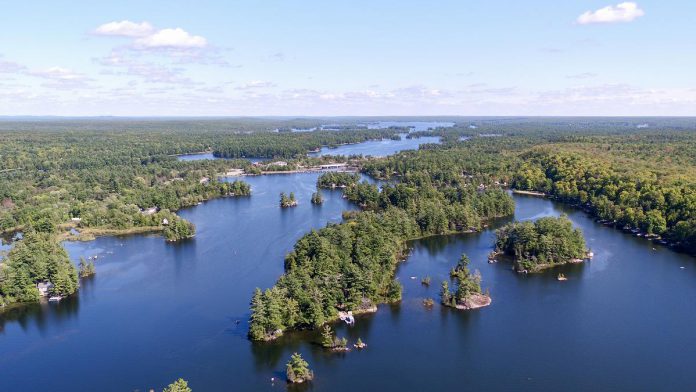
Selwyn Township council is supporting the first step in completing a lakeshore capacity assessment of Lovesick Lake by approving a resolution to consult with surrounding municipalities and others on a terms of reference for the assessment.
At its regular meeting on Tuesday (September 10), council received a presentation from the Lovesick Lake Association and the Committee for the Preservation of Lovesick Lake about the levels of phosphorus in the small lake, which is located west of Burleigh Falls on the Trent-Severn Waterway between Lower Buckhorn Lake and Stoney Lake.
Dian Bogie, Lovesick Lake Association treasurer and cofounder of the Committee for the Preservation of Lovesick Lake, spoke to the need for a lakeshore capacity assessment.
“(Lovesick Lake) has the highest phosphorus levels on the whole Trent-Severn Waterway and, for the past two decades, it often exceeds the provincial guideline of 20 micrograms per litre,” Bogie told councillors. “It’s on the tipping point of becoming a eutrophic/dead lake. It’s a perfect candidate for a lakeshore capacity assessment.”
Bogie referred to the Ontario government’s handbook for completing lakeshore capacity assessments, described as a planning tool that can be used to control the amount of phosphorus entering inland lakes on the Precambrian Shield by controlling shoreline development. While the goals of lakeshore capacity assessment are to help maintain the quality of water in recreational inland lakes and to protect coldwater fish habitat, they can an carried out on any inland lake.
Bogie’s presentation was prompted by an official plan amendment and zoning by-law amendment application received by the township earlier this year from Lovesick Lake Park at 3340 Strickers Lane for a proposed 40-site trailer park expansion. The expansion of the trailer park, which currently has 160 seasonal sites and 20 overnight sites, would also include a new road, septic systems, garbage facilities, and parking.
“The expansion of this trailer park threatens to increase (phosphorus) levels even more due to increased runoff and pollution, further degrading water quality and threatening aquatic life,” stated a media release issued by the Lovesick Lake Association on June 11. “Phosphorus pollution can also lead to harmful algal blooms, which pose serious health risks to both humans and wildlife.”
VIDEO: “Lovesick” documentary by Lauren Bridle (2017)
In addition to the issue of phosphorus levels in the lake, the association’s media release also expressed concerns about the impact of the proposed expansion on the already-crowded public boat launch at Lock 28 on Highway 28, as well as increased traffic on Forest Hill Road and related safety risks.
The following week, on June 17, Selwyn Township council held a special public meeting to consider the proposed official plan and zoning by-law amendments, where they received presentations from municipal planner Per Lundberg as well as the applicant’s agent DM Wills, along with many public delegations opposing the proposed expansion.
Lundberg’s report to council, which also provided compiled comments on the proposed expansion from an earlier public meeting, recommended that council defer a decision on both amendments to a future date “following consideration of public comments received at the public meeting.” Council voted in favour of a resolution supporting Lundberg’s recommendation.
Lundberg’s report also noted that council members had been asked to complete a lakeshore capacity assessment for Lovesick Lake and to implement an interim control bylaw to prevent any further development pending the completion of the assessment.
“Any decision to move forward with a (lakeshore capacity assessment) would, at minimum, require discussion and agreement from the County of Peterborough and the three municipalities bordering the lake (Selwyn, North Kawartha and Trent Lakes),” Lundberg wrote.
“The township would not be in position to pass an (interim control bylaw) until such discussions were concluded. Should the councils stated decide to proceed with a study, then the terms of reference of such study including its scope, resource allocation, and timing would need to be confirmed.”
The resolution presented at council’s September 10 meeting stated:
“Whereas Lakeshore Capacity Assessments under the Official Plan are a requirement for cold water lakes specifically to protect lake trout; and although Lovesick Lake is a warm water lake thereby not meeting the requirement to complete a Lakeshore Capacity Assessment, the Ontario Lakeshore Capacity Assessment Handbook (LCAH) can be used as a guiding document if municipalities and stakeholders wish to conduct such assessment.”
“Whereas the first step is to determine if there is agreement from the municipalities with jurisdiction over properties around Lovesick Lake, including at a minimum, Trent Lakes, North Kawartha, Selwyn and the County of Peterborough, as well as Parks Canada/Trent Severn Waterway to consider the development a Terms of Reference outlining the scope, purpose and resourcing of such Assessment.”
“That these organizations be consulted to determine interest in considering the preparation of a Terms of Reference for a Lakeshore Capacity Assessment.”
After hearing Bogie’s presentation, councillors discussed the resolution and proposed that it be amended to note that Lovesick Lake is a “flow-through lake” feeding the Trent-Severn Waterway and that Curve Lake First Nation and other Indigenous communities also be included in the consultation list.
In response to a councillor’s question, Bogie indicated that while Lovesick Lake Association would not be able to contribute in a significant way financially to the work due to the small size of its membership, association members would be happy to participate such as by conducting research.
Councillors voted to support the amended resolution.


























